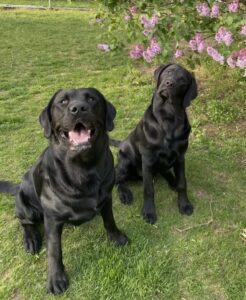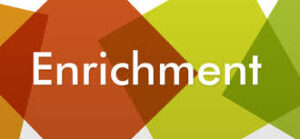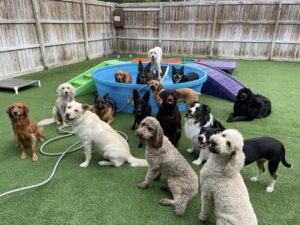 As most of you know, Kate added to her family twice this past year. Dutton and Wheeler, sweet and beautiful Labrador Retriever puppies, have filled her days with activity, a little insanity, big Vet bills, and a lot of joy. All of this puppy energy has had Kate thinking a lot about home enrichment activities. Her research and passion for this topic have benefited Play All Day as well. So I thought it would be a good time to pass some of this information along to you. Join us today as we delve into all things enriching to a dog’s world.
As most of you know, Kate added to her family twice this past year. Dutton and Wheeler, sweet and beautiful Labrador Retriever puppies, have filled her days with activity, a little insanity, big Vet bills, and a lot of joy. All of this puppy energy has had Kate thinking a lot about home enrichment activities. Her research and passion for this topic have benefited Play All Day as well. So I thought it would be a good time to pass some of this information along to you. Join us today as we delve into all things enriching to a dog’s world.
We will explore why licking, chewing, sniffing, problem-solving, searching, and social time can help your dog to live a more enriched life.
For most of our dogs, their lives revolve around our lives. Their schedule is dictated by us, down to when they eat, sleep, sniff, and toilet. Very little is really in their control. It is no wonder they are so happy to see us and get excited when our attention turns their way. Sleep occupies a large part of a dog’s schedule….most of it needed, but part of it just because there is nothing better to do. By considering an enrichment plan for your dog at home, you can not only add to your dog’s happiness, but you can add to their mental and physical health…and perhaps make their day a little less mundane. And I will wager that you will see some benefits as well.
Licking:
 Most dogs love to lick. There are many reasons that dogs lick and one of them is because it feels good. It is suggested that when a dog licks, endorphins are released and bring pleasure. Whatever the reason, we know that dogs like to lick and this can be a target for some of your enrichment activities at home. We have used peanut butter stuffed Kongs in our boarding facility since we opened. We put peanut butter in them and freeze them. Our hotel guests get them at bedtime. We found that they are helpful in helping a dog to relax at a stressful time in their stay…a time when they are usually snuggling up to Mom and Dad at bedtime. The licking of the peanut butter distracts the dog and possibly releases endorphins and reduces the stress of being away from home. And most dogs love food, so the peanut butter is a nice treat in addition to the benefits of licking. You can provide licking for your dog in many ways. The stuffed Kong, lick mats, frozen treats, and special lick toys are a few.
Most dogs love to lick. There are many reasons that dogs lick and one of them is because it feels good. It is suggested that when a dog licks, endorphins are released and bring pleasure. Whatever the reason, we know that dogs like to lick and this can be a target for some of your enrichment activities at home. We have used peanut butter stuffed Kongs in our boarding facility since we opened. We put peanut butter in them and freeze them. Our hotel guests get them at bedtime. We found that they are helpful in helping a dog to relax at a stressful time in their stay…a time when they are usually snuggling up to Mom and Dad at bedtime. The licking of the peanut butter distracts the dog and possibly releases endorphins and reduces the stress of being away from home. And most dogs love food, so the peanut butter is a nice treat in addition to the benefits of licking. You can provide licking for your dog in many ways. The stuffed Kong, lick mats, frozen treats, and special lick toys are a few.
- The stuffed Kong has been around forever in the dog world and is a good option. The biggest drawback is that they are not easy to clean if your dog does not fully eat all of the stuffing. You will need an old toothbrush and a little bit of elbow grease to keep it clean in between uses. Also, some dogs do not like the shape and give up on it a little too easily.
- Lick mats are a great entry-level lick toy. They are a silicone mat with some sort of texture. You can smear peanut butter, canned dog food, or anything creamy onto the mat and the dog will lick it off. They clean easily, but the distraction time is not great unless you keep refilling it. Freezing a loaded lick mat will help to increase its duration.
- Until you know how your dog will interact with a lick mat, I recommend supervising. Some dogs will try to eat the mat to get every last drop.

- Making frozen broth treats is a fun way to let your dog lick. They can last a bit longer based on how big they are. But they can be messy if they melt faster than your dog licks. Best to try this one outside at first.
- Our new favorite at Play All Day is the Pupsicle by Woof. This one is easy to use and clean. And it can give up to 30 minutes of lick time. My dogs are a bit obsessed with ours right now. One of the nice features of this toy is that you can buy ready-made refills or you can make refills using their silicone freezer tray. Learn more here.
- One of Kate’s new favorites is the West Paw Toppl. It is very much like the Kong, but much easier to clean and has another layer that can be added to increase the difficulty and duration of licking. Here is a video on the Toppl.
I love licking enrichment activities for my dogs. It is Willow’s favorite activity by far. Not only does licking provide some enrichment to your dog’s life, but it is also a great distraction tool. Willow is notorious to all of our friends who visit our house. She demands to be the center of attention and makes a lot of noise when she is not. We have found that licking activities are a great distraction for her. So when company arrives, she gets a licking toy (love the Pupsicle for this) and she is happy and distracted.
Please note that not all licking is healthy. Obsessive licking can be a sign of a psychological issue or a medical issue. If you notice that your dog is licking everything or licking too much of the time, you should consult your Veterinarian or Behaviorist. Please feel free to discuss this with us if you need help determining just how much licking is too much licking.
Chewing:
Just like licking, chewing can be very pleasurable for a dog. A dog’s mouth and jaw are designed to chew. Dogs enjoy it and there are a lot of options out there. But providing safe chewing options does take a bit of thought and planning.
- I am not a fan of the commercial dental chews that are so popular now. There is an awful lot of synthetic material in the chews and they are not very digestible. Most dogs are able to break off big chunks at a time while chewing. If these pieces are swallowed, they sit in the stomach for a long time and can cause stomach upset. This puts the stomach into a continued state of acid overproduction. This same thing can happen with most hard chews in which a dog can break off bigger pieces and swallow. I have found that more natural chews such as bully sticks and Himalayan chews dissolve and digest faster than the commercial dental chews. But even with that, they can cause stomach upset. I still give my dog bullysticks but I monitor them closely and only allow them to consume small bits at a time. And if stomach upset occurs, this is an indication that it may not be the best chewing option.
- Hard synthetic bones can be a good chewing alternative. But you must monitor this closely. If your dog is an aggressive chewer, pieces can be broken off and swallowed. This is not very common but does happen. It happens more frequently as the chew gets older.
- Antlers are another good chewing option but must be monitored closely as well. They are hard and if a dog is too aggressive, tooth damage can occur.
- My favorite chew is a raw marrow bone. They are hard and satisfying for a dog, but not so hard that tooth damage is as likely with an antler. They are very satisfying to a dog as they typically have some tissue on the outside and the dog can shred the tissue from the bone which is a natural behavior. The dog also gets to lick to get the marrow from inside of the bone.
- A few rules to follow with chew items:
- The chew should be a few inches wider than the width of the dog’s mouth. Anything smaller can be swallowed and choking is a hazard.
- Bones should be fed raw. Cooked marrow bones will splinter and can be a choking hazard.
- Until you know how your dog will interact with a new chew, monitor them closely. I do this for a few sessions. And anything that has the potential to break off and be swallowed, I always monitor.
Sniffing:
 If I were to offer you just one enrichment activity, this would be the one. I think all of them are important in developing a well-rounded program for your dog, but I think sniffing is the one that is most important to dogs and one that is so often restricted by parents (often innocently).
If I were to offer you just one enrichment activity, this would be the one. I think all of them are important in developing a well-rounded program for your dog, but I think sniffing is the one that is most important to dogs and one that is so often restricted by parents (often innocently).
Not only is sniffing the most important enrichment activity for your dog, it is also the easiest for you to provide. Simply put, let your dog sniff. Awareness is half the battle here…knowing that your dog needs to use his nose. Our lives are often a rush. Get up, get ready for work, let the dog out, feed the dog, off to work. It can be hard to wait for your dog to get done sniffing, and we often rush them along, telling them to hurry up. If you can budget two extra minutes into your morning routine, just to let your dog sniff at will, it is beneficial.
When you go for a walk with your dog, share the time with them. If you are truly on your walk for the dog’s sake, incorporate sniffing into your plan. Physical exercise is important for your dog and walks are a great way to provide that. I would suggest that sniffing is every bit as important to your dog as physical exercise. The majority of your dog’s perception of the world is coming from his nose. Taking that away from our dogs is similar to us losing our sight. I recently saw a quote about us rushing our dogs through their sniffing (sorry, can’t remember where I saw it). It likened us yanking our dog away from a good sniff to a human only being given 30 seconds to view one of the Seven Wonders of the World. Perhaps that’s a little dramatic, but you get the point.
I wrote a blog on this topic several years ago and it is still true today. You can read it here. “Whose Walk is it Anyway?” In the post, I talk about sharing your walk with your dog, allotting time for sniffing and time for exercise. Since I wrote it, I have taken it one step further. Now I suggest incorporating entire walks to the dog for sniffing alone. Set a duration in your mind and then let your dog choose the route and let him sniff as much as he wants. You may not walk a block, but your dog will be thrilled with the walk. Two 20-minute sessions of this each week will do wonders.
Finding:
 Finding is an extension of Sniffing, in my opinion. I’m giving it its own section here because it can be a great enrichment activity to use in your house or yard. Finding can be done with toys, food, or people.
Finding is an extension of Sniffing, in my opinion. I’m giving it its own section here because it can be a great enrichment activity to use in your house or yard. Finding can be done with toys, food, or people.
It is my boy Cygnus’ favorite activity, right up there with swimming. Cygnus has a basket of “babies” which are all his stuffed toys. Cygnus adores his babies and tries to be fair in giving them all some playtime each week. Our “Find Your Baby” game consists of me asking Cygnus for a sit/stay and then hiding his baby somewhere in the house and then releasing him to find his baby. He uses a combination of memory and sniffing to find his baby. Memory is displayed when he goes to some of our more frequent hiding spots before using his nose. Once he realizes they are not there, he starts using his nose to track it down. We do not use a food reward for this game because the game itself and finding his baby is the reward. We’ve been playing this game his entire life and we did not start with a sit/stay and the hiding places were very simple. As his training skills increased and his finding abilities increased, I increased the difficulty level.
Start simple. If your dog does not sit/stay, use a closed door or have someone hold him while you hide the toy. Let your dog have success with simple hiding spots at first and then make them more difficult. You may be tempted to help your dog find the toy, but resist. If he is really struggling, just casually stand in the vicinity of the toy as a guide. If you constantly help, your dog will look to you and not his nose.
If your dog is not toy-motivated, use food treats to hide. You can hide a tasty treat somewhere in the house to find. I know some folks who will throw their dog’s entire meal into the grass and let the dog find each piece of kibble. Snuffle mats are a simple form of find it. Kibble is hidden within the mat for the dog to sniff out and eat. Family members are also great to “find” for your dog. This is such a great activity and can be played indoors during bad weather. When we go on hikes, my husband will hold Cygnus and I will hide in the woods. Great fun for all when he finds me. There are so many options for Finding games and your dog will love you for it.
Problem Solving:
 I look at problem-solving as an exercise for the brain. And just like sniffing, it can tire a dog out as easily as exercise. I admit that I am guilty of helping my dog solve problems too often. Lately, I’ve been stepping back and letting him figure it out. So when a ball goes under a piece of furniture, I’m letting Cygnus figure out how to retrieve it. When something he wants is on the other side of a barrier, I’m not showing him the way to get beyond the barrier. It’s really cool to watch your dog’s problem-solving abilities. Look for ways that you can create “problems” for your dog to solve in everyday life.
I look at problem-solving as an exercise for the brain. And just like sniffing, it can tire a dog out as easily as exercise. I admit that I am guilty of helping my dog solve problems too often. Lately, I’ve been stepping back and letting him figure it out. So when a ball goes under a piece of furniture, I’m letting Cygnus figure out how to retrieve it. When something he wants is on the other side of a barrier, I’m not showing him the way to get beyond the barrier. It’s really cool to watch your dog’s problem-solving abilities. Look for ways that you can create “problems” for your dog to solve in everyday life.
For enrichment, you can help your dog use his brain by allowing him to solve everyday problems on his own. You can also offer puzzles. There are puzzles that you can purchase and puzzles that you can make at home. The key to puzzles is to make them easy at first so that your dog can succeed and then add complexity as he gets better at solving them.



One of the trendiest DIY puzzle toy in the past few years has been the folded towel. Take a peek at the YouTube video to make your own. If you are not interested in making your own, PAD will have an option (The Snuffle Knot) in our retail market soon. Kate has tried it out with her boys and it was a hit.
Socializing:
 Being social is another form of enrichment. If your dog is attending daycare, he is getting socialization. But even if you attend daycare, different forms of socialization will broaden your dog’s world. If appropriate, meeting new dogs and new people will open your dog to new experiences and new scents.
Being social is another form of enrichment. If your dog is attending daycare, he is getting socialization. But even if you attend daycare, different forms of socialization will broaden your dog’s world. If appropriate, meeting new dogs and new people will open your dog to new experiences and new scents.
And if a car ride is available, we all know how exciting and tiring a car ride can be. A trip to an outdoor café is very enriching. “Growing” your dog’s world is a wonderful variation of enrichment.
We love our dogs. And we want to do the best for them. A program of enriched activities throughout the week can benefit your dog. And never underestimate just being with your dog, truly being with your dog, not distracted by TV or social media. Lay on the floor with him and be present. Give a massage. Read from your book out loud. Listen to some music. Just yesterday, I made a big deal of preparing peanut butter sandwiches for my kiddos. I sat on the couch with a jar of peanut butter and a bag of their treats. I carefully applied peanut butter to the cookie (had to make a big show of it) and had a snack session. They loved it. Enrichment comes in many forms and doesn’t have to be difficult. You just have to remember to do it. Your dog will thank you.


Sample Enrichment Calendar:
Sunday:
Free sniffing for 3-5 minutes in the morning and before bed
A game of “Find It” for 10 minutes in the afternoon
A car ride to a new park for a walk
Monday:
Free sniffing for 3-5 minutes in the morning and before bed
A lick toy when you leave for work
A chew toy during TV time
Tuesday:
Free sniffing for 3-5 minutes in the morning and before bed
A lick toy when you leave for work
A sniff walk for 15 minutes with no rules
Wednesday:
Free sniffing for 3-5 minutes in the morning and before bed
A lick toy when you leave for work
A puzzle toy while you watch TV that night
Thursday:
Free sniffing for 3-5 minutes in the morning and before bed
A lick toy when you leave for work
Dinner served outside
A special chew while you watch TV that night
Friday:
Free sniffing for 3-5 minutes in the morning and before bed
A lick toy when you leave for work
A 10 minute sniff walk when you get home from work
A snuffle mat filled with treats when you leave to go out for date night
Saturday:
Free sniffing for 3-5 minutes in the morning and before bed
A 30 minute walk in a new place, with 15 minutes of walking and 15 of sniffing
Visit a family member or friend, or have friends visit. Give a lick toy to settle your dog when company first arrives to help him settle in.






